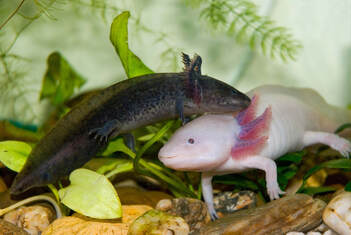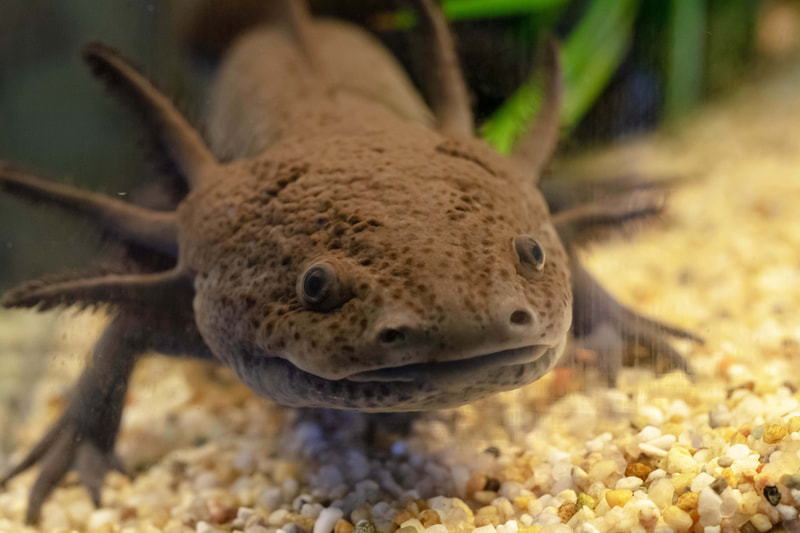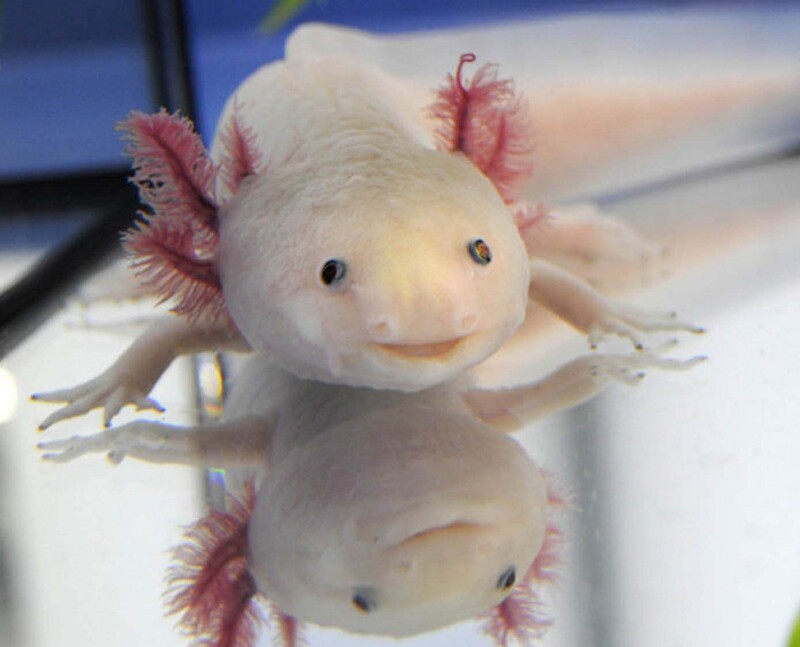Axolotl (Ambystoma mexicanum)

Physical Description: The Axolotl (pronounced axo-LO-tuhl) is a neotenic salamander, meaning they retain certain larval characteristics in the adult, reproductive state. They possess feathery external gills and finned tails for swimming. Wild axolotls are dark-colored and can shift their hue a few shades lighter or darker as needed for camouflage!
They can grow up to18 inches long and weigh between 2 and 8 ounces. Axolotls have a broad, flat body with a large head donning its signature feathery gills. Round, dark eyes with yellow, iridescent irises help the axolotl to see in murky environments. It has strong limbs that carry it along the lake bottom.
Habitat: The Axolotl lives its entire life underwater, supported by its external gills.
Range: The Axolotl is only native to Lake Xochimilco and Lake Chalco in central Mexico. Unfortunately for the Axolotl, Lake Chalco no longer exists as it was drained by humans to avoid periodic flooding, and Lake Xochimilco remains a diminished glimpse of its former self, existing mainly as canals.
Diet: The Axolotl is a carnivore. They eat worms, tadpoles, insects, small fish and zooplankton. They do not chew their food, instead they use suction to capture a meal.
Life Span: The Axolotl lives up to 15 years in human care, and 5 on average in the wild.
Social Structure: The Axolotl is a solitary animal, engaging with others of its kind only during the breeding season. After mating, the female will lay between 300 and 1,000 eggs in the water. Each egg is individually laid and is attached to a protective substrate like plants or rocks to protect them from predators. The eggs will hatch in about two weeks and the young Axolotl are independent from the moment they emerge from their eggs.
Status: Critically Endangered. There are an estimated 50-1000 Axolotls left in the wild1.
Other: They can regenerate their limbs, lungs, heart, jaws, spines, and even parts of their brain! Scientists have found that axolotls can regrow a new limb five times perfectly, in a few weeks—without even a scar. Every tissue is replaced: skin, bone, cartilage, muscle, and stem cells. Other organs can regenerate countless times and be completely functional. Axolotls are important in medical and scientific research because of their unique regenerative qualities as well as their neotenic characteristics.
References: 1 https://www.iucnredlist.org/species/1095/53947343
They can grow up to18 inches long and weigh between 2 and 8 ounces. Axolotls have a broad, flat body with a large head donning its signature feathery gills. Round, dark eyes with yellow, iridescent irises help the axolotl to see in murky environments. It has strong limbs that carry it along the lake bottom.
Habitat: The Axolotl lives its entire life underwater, supported by its external gills.
Range: The Axolotl is only native to Lake Xochimilco and Lake Chalco in central Mexico. Unfortunately for the Axolotl, Lake Chalco no longer exists as it was drained by humans to avoid periodic flooding, and Lake Xochimilco remains a diminished glimpse of its former self, existing mainly as canals.
Diet: The Axolotl is a carnivore. They eat worms, tadpoles, insects, small fish and zooplankton. They do not chew their food, instead they use suction to capture a meal.
Life Span: The Axolotl lives up to 15 years in human care, and 5 on average in the wild.
Social Structure: The Axolotl is a solitary animal, engaging with others of its kind only during the breeding season. After mating, the female will lay between 300 and 1,000 eggs in the water. Each egg is individually laid and is attached to a protective substrate like plants or rocks to protect them from predators. The eggs will hatch in about two weeks and the young Axolotl are independent from the moment they emerge from their eggs.
Status: Critically Endangered. There are an estimated 50-1000 Axolotls left in the wild1.
Other: They can regenerate their limbs, lungs, heart, jaws, spines, and even parts of their brain! Scientists have found that axolotls can regrow a new limb five times perfectly, in a few weeks—without even a scar. Every tissue is replaced: skin, bone, cartilage, muscle, and stem cells. Other organs can regenerate countless times and be completely functional. Axolotls are important in medical and scientific research because of their unique regenerative qualities as well as their neotenic characteristics.
References: 1 https://www.iucnredlist.org/species/1095/53947343








